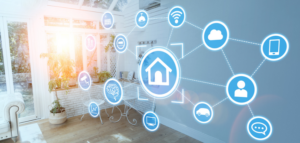
07 Dec Smart home: AI at the service of everyday life
Among the environments most affected by the digitization process, there is undoubtedly the domestic scene. In recent years, the smart home phenomenon has become increasingly popular.
But what is it all about?
What is a smart home?
The term smart home refers to a home in which certain technological components are perfectly integrated and connected and can be controlled directly from mobile phones, voice assistants, or, in general, remotely. In concrete terms, this means that specific home appliances, lights and blinds can be managed through a wifi connection from special apps even when we are not physically at home.
Any technological device in a smart home is potentially ‘smart’: it simply needs to be connected to the internet and be integrated within the home network.

Applications in everyday life
Products and technologies for smart homes are increasingly present on the market, as they not only help to improve comfort at home but they also contribute to safeguarding the environment through energy savings while ensuring more safety and security for people.
Among the various devices that can be made smart:
- Electrical system: an intelligent electrical system makes it possible to control lights, shutters, and various power sockets. The user simply needs to install and connect all devices to the network to use them according to his daily needs.
- Video intercom: a smart intercom that allows users to simply click on a button to perform actions such as opening up a gate; the gate can be opened without moving from the couch with a simple click;
- Smart lifesaver: thanks to the smart lifesaver, smart homes can be monitored anywhere and at any time. The device alerts users with a notification in the event of faults, power cuts, problems with household appliances or with the heating system;
- Thermostat: an intelligent solution that allows the heating system to be managed remotely via smartphone;
- Audio system: the system, made of smart speakers and loudspeakers, is capable of bringing music and sound to every room in the house. Itcan be managed and controlled with a few taps on a smartphone or through simple voice commands using the voice assistant.

The advantages of the smart home
Home automation technology makes it possible to live in an environment of high comfort, capable of always responding to the needs of those who live in it. However, above everything, the home automation system is a big step towards the protection of our planet, increasing energy savings by around 30% compared to traditional solutions. By connecting the home automation system to photovoltaic energy sources, total energy savings can be achieved.
In conclusion, turning a home into a smart home has several interesting advantages including:
- Hyper-connectivity: the home automation system will allow a continuous connection with all house spaces thanks to the control of each room via app or smartphone;
- Simplicity in the transformations of the installations: all the functions in a smart home can be modified without the need of laying new electrical lines nor completing major masonry works;
- Consumption savings: home automation systems contribute to keeping energy consumption under control and optimize energy savings;
- Safety improvement: a home automation system constantly monitors every aspect of the house, warning the user, in real time, of any anomaly in the home environment;
- Increased living comfort: smart homes allow better management of domestic activities through the use of automated appliances;
- Assistance for the elderly and disabled people: intelligent houses help ensuring a better quality of life for these individuals by encouraging an increase in autonomy and independence and, consequently, in their personal safety.





